
Two New Chassis And A Whole New Look For Arrow
TweetThis is the new look for Arrow!
The entire range from the Australian manufacturer has had a facelift with new colours and a modern edgy design. There are also two new chassis models – the Arrow X2 CIK and Arrow X2 Cadet/Rookie.

Above: Arrow's new X2 CIK kart (click for a larger version)
The CIK kart is a completely new chassis design to cater for the 125cc classes. It will begin to be shipped to dealers in 30/32mm spec from today (Friday). 30/30mm and 32/32mm spec karts will come online later in the year.
The second new kart is the Cadet/Rookie which features an adjustable wheelbase. The kart has undergone testing around the country and will be available later in June.
“The National & Clubman chassis designs have not changed but we have upgraded several components and with a complete new look, these will all be available from the first of June" DPE/Arrow Sales and Marketing Manager, Steve Johnson, informed KartSportNews.
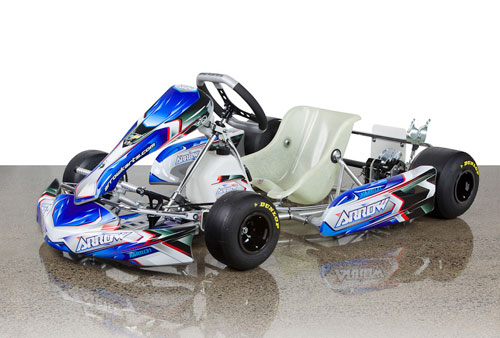
Above: Arrow X2-28J Junior kart
The majority of dealers will start to receive their new X2 karts from Monday, June 4. Arrow will also have the X2 on display at some upcoming events.

Above: New karts in the showroom at DPE's Melbourne factory. Expect to see this type of presentation at a number of dealers and race tracks around the country
It is anticipated there will be quite a number of the new karts at the 50th anniversary AKA Nationals in Darwin. “All Arrow dealers are able to purchase these new karts so we do expect to see plenty of new Arrows on the grid across all the categories.”
arrowkarts.com.au now has the spec sheet and photo gallery for each model:
- Arrow X2-28J - specification page and image gallery
- Arrow X2-28N - specification page and image gallery
- Arrow X2-28C - specification page and image gallery
- Arrow X2-31C - specification page and image gallery
- Arrow X2-CIK - specification page and image gallery
Arrow X2 CIK
The X2 CIK kart from Arrow marks a new chapter in the iconic Australian kart manufacturer’s history. Already known around the world for quality, performance and presentation, the tech boffins at DPE have undertaken unprecedented analysis of materials and design to come up with the X2. It would have to be the most understood chassis to come out of Arrow.
Arrow’s Research and Development Manager, Bart Price, told KartSportNews that the number of items that are measured and considered in the design and build of the kart has blown out compared to the past.
“We are now analyzing the material of every single component of the kart and the effect each has. In the past we might have looked at the material of the chassis and 40 to 50 dimensions that we focused on. But now, that number of items has gone up to 90 or 100. That is one of the biggest things that has changed. There is just more and more that we analyze.”
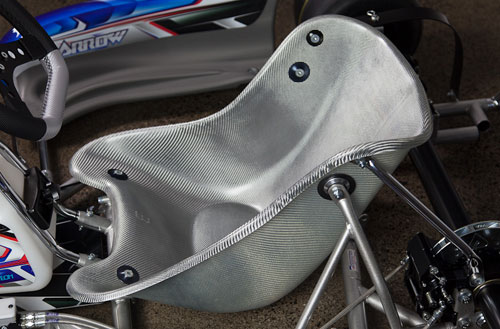
Above: IMAF seat in the Arrow X2 CIK
As a result, Price said that things they didn’t realize were having an effect on the performance of the kart were actually having a dramatic effect.
“For example, in the seat mounts, we’ve had the same material for years and never really thought much of it. But that’s all changed. With the CIK kart, we’ve gone a lot softer in the seat brackets than where we’ve been.
The change in material properties through the kart has been quite dramatic, and while the seat brackets are softer, the chassis’ rear axle bearing brackets are far stiffer.
“With the steel bearing hanger material, we’ve gone the opposite way. When we were comparing ours to several opposition brands of kart, it was obvious we were too soft in the bearing hangers (tested by putting a bar through the rear end and measuring the load and flex through the bearing hangers).
“The main thing that changed in performance there was - the first five laps, really, it made no difference. But after five laps when there was a bit of heat in the tyres, and especially on the Mojo tyre where you get a fair bit of tyre shudder, the different bearing hanger material tended to make us last a lot longer.”
The main chassis rails are wider apart at the rear of the kart which has settled its behavior, particularly on corner entry.
“With our karts, we’ve found that, while they could be fast, they were quite nervous to drive. What that meant for – and I wouldn’t even say your average driver, but any driver that’s not David Sera - it was very difficult for someone to post lap after lap at top speed, myself included. The consistency was the biggest problem. It was nervous entering the corner without making a mistake and the extra width in the back of this chassis has really helped stabilize that.
“But probably the key thing that’s had a big impact on (reducing) the nervousness of the kart is the front end geometry - the angles at which the tie-rods mount from the stub axle to the steering shaft.”
The revised angles mean the amount of toe-out due to Ackerman as more lock is applied, does not increase to the extent it did before.

Above: Steel stub axles on the X2 with multiple pickup points on the steering arm to change Ackerman and steering ratio
“As we were, as you turned on more lock, the Ackerman was increasing and we ended up with a lot of Ackerman. But by bringing the (steering shaft) pickup back we’ve reduced the amount of Ackerman on turn-in, making it a lot less nervous to drive on the entry to the turn.”
The braking system is the same as the previous model. “We’ve been working on a self-adjusting system which we hope to introduce a bit later, but it’s not finalized yet.”

Above: Rear ride-height adjustment and bearing mount (pic is of the Clubman kart)
When it comes to the general layout of the X2 chassis, the kart’s overall shape has its roots in the original development for the X1-E.
“The basis of this design (the X2) was considered as part of that development and we were really knife edge at the time over which kart to go with before we went with the X1-E shape.
“And while that’s been a good kart, I couldn’t say it’s been the kart of choice for a lot of people. Therefore we’ve continued to focus hard on this design.”
One of the problems this kart will face is the various tyre compounds that it will potentially race on. However, Arrow are confident they’ve now got an effective tuning tool to cope with the different grip levels.
“By changing the way the main rails pick up the front beam, we’re now getting a bigger difference when the front torsion bar is in or out, and this helps us tune for the different tyres.
“This kart’s going to have people racing it with MG Reds – and we could be talking a C-grader with 4 or 5 race meeting old MG Reds - versus someone going out in Leopard on brand new MG Yellows. The grip level difference is dramatic.
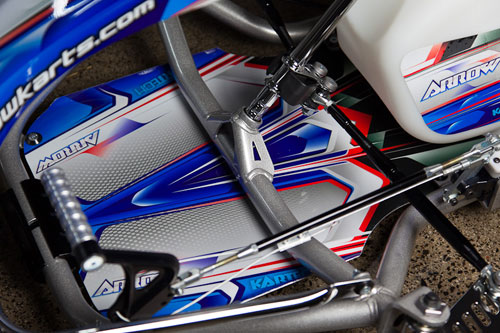
Above: New colours for the X2-28
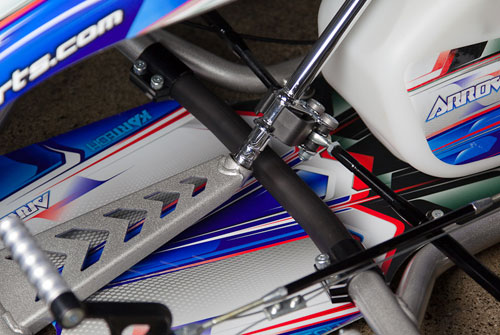
Above: Removable chrome-moly torsion bar on the X2 CIK
“By changing the front to what we’ve got now, we have a bigger tuning aide to deal with the different grip levels. In basic terms, the higher the grip level of the tyre, the softer we run in that section of the kart. So, on MG Yellows we’ve had more success if the bar is removed completely, but on MG Reds we’ve had the most success running a chrome-moly bar across the front. That’s a little different to our opposition, who tend to use a standard mild steel which is fairly soft. This kart will have two different grades of torsion bar and the stiff version is the same material used in the chassis and has the greatest impact.
Further material changes - and not just in dimension - have been made in the main part of the chassis. The entire chassis is chrome-moly, but of differing tensile strength.
“In this kart we’re running a much softer main rail tube, but across ways – the rear bar, centre bar and front hoop – is higher tensile steel.
“Everyone is looking for as much grip as they can, obviously without getting to the point of robbing engine power. With going stiffer across-ways and softer long-ways, we’ve found it enables the kart to keep its momentum up when it’s sliding which also makes it more consistent to drive.
Price said they have gone to a lower tensile steel in the front C-sections that mount the stub axles (which have reverted to steel items once more), and this and the softer seat brackets have aided the kart’s ability to ride bumps.
“I think the C-section and the seat stay material has been the key ingredient to allow us to ride the bumps better. I didn’t realize it was such a problem for us until we made those changes.
“We have the perfect track to test that down at Oakleigh. It’s an extremely difficult and demanding track, it requires a kart to change direction more than any other track in the country and on top of that now, it’s become so rough that riding the bumps is critical. When we made those two specific changes, I couldn’t’ believe how many more kerbs on the track I could run straight over without it having a big effect on performance.
“Same thing goes with seat bracket material. When the kart gets a bounce up – and the perfect example is the double right hander at Todd road, when you’re running on a softer tyre, you might clip the inside kerb on entry and get into a bounce and the bounce might continue four, five or six times through the corner and you find yourself just trying to gather it just to get around the corner. But when we went softer through the seat bracket material, as the kart got a bounce, it tended to solve itself, or bring itself back down to stable after one or two bounces rather than continuing into five or six. So on that double-corner, by midway through, the kart was balanced again and ready to get the apex for the next part.
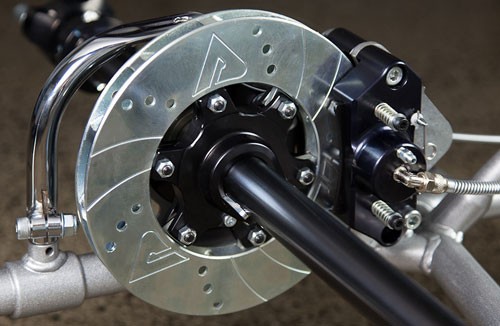
Above: Brake on the X2-28
While the kingpin inclination remains unchanged, there is a slight increase in caster. “Karts are running much more caster than in the past. For example, only 5 years ago, we were running around 14 degrees of caster, and now with it in the central position we’re running 19.5 degrees caster. And tuning to get the optimum performance, we can use the adjusters to get to 22 degrees.
A side-effect of more caster is heavier steering.
“Definitely, it’s heavier in the front, which is why we’ve also changed the distance between the king pin and the pickup point of the tie rod. That leverage point changes how heavy the steering is and now we’ve got two positions – as you bring that back, you get lighter steering but lose some of the feel, but move it forwards and it’s heavier and more physical to drive, but you do get a bit more feel. Also to cater for the heaviness in the steering, we’re slightly larger in the diameter of the steering wheel. A pretty common dimension was 320mm in diameter, but now we’re out to 330mm, and there are steering wheels on the market that have pushed on to 340mm.
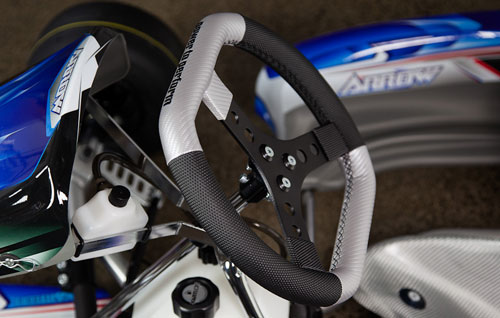
Above: New and wider steering wheel on the X2 CIK
Arrow are now fitting the Italian IMAF seat as a standard component for the CIK kart.
“Personally, I find it to be a more comfortable seat and seem to be sitting more in the kart than on top of it. We have the option of different stiffnesses to play with down the track, but the one we’ve found works best all-round is what we are fitting.
Static ride height out of the factory has been tweaked and is now 3mm lower in the front. “We’ve brought the floor tray up to give a bit more clearance in the middle and eliminate some of the clearance problems some other brands have. We’re also thicker in the floor tray to offer more support through the waist of the kart.”
Rear ride height remains the same with 12mm of adjustment in three increments.
The kart comes with a 50mm medium ‘black’ axle. A black axle will now be supplied as standard in the full range of karts and will also be available aftermarket in the medium grade.
“One of the things Steve bought to us was getting back to giving every single component on the kart the best finish we can, hence why the black has ended up in there. In 50mm, we have 5 different tensile strengths, then you’ve got the different lengths they can be cut down to.

Above: Quick-change sprocket carrier is standard
With this kart, Arrow has gone right back to the design stages and analysed everything they were doing with their kart and also what their opposition was doing.
“I feel now that we’ve got the best understanding that we’ve ever had as to where our opposition sits in every area – and that’s no doubt helped us.
“I feel we have an edge over out opposition when it comes to our local classes, where you’re talking from Cadets through National class and Clubman type classes. But until now, in the let’s call it TaG-slash-CIK type classes, we’ve been a little bit behind the eight-ball at the top end of the market, and the process we’ve gone through with this CIK kart I feel has really brought us up to the top. And what we’ve learnt from doing the analyzing in the workshop – I can’t harp on enough how many more things we are taking into consideration now than what we have in the past.
“Every material on this kart and on the opposition karts we’ve analyzed gets taken and torn apart to measure the tensile strength etc and it’s melted down to measure every chemical in the material. It’s a big project and it’s costly.
“But it’s never ending…"

Above: Arrow X2-28
Arrow X2 Cadet/Rookie
The most visible change on the Cadet/Rookie kart, apart from the new look, is the adjustable wheelbase via moving the entire rear axle assembly forwards or backwards in the chassis..
“We used to produce a 90cm and a 95cm wheelbase Midget/Rookie kart - two different karts” Price explained. “That can be a bit overwhelming for a father with a 7 year old kid who feels they’ve got to have two different karts. So now we have an adjustable wheelbase that takes the kart from 905mm to 925mm to 945mm – three adjustments.”
“From Cadets through to Rookies, the size of kids changes so much that they’re literally growing out of their kart from meeting to meeting. But now we’re able to get a better tuning aide for the different sized kids.”
While the adjustable wheelbase was the key change, the kart also has the rear cross rail re-positioned, the caster angles are slightly different and the centre rail has been moved.
“In saying that, the centre rail will remain with the split section through it which we find tends to help the little kids by making the kart a bit more forgiving.”
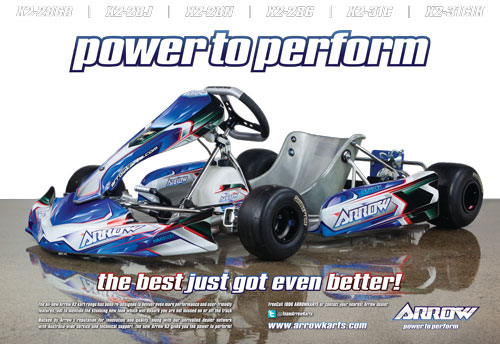
Above: Arrow advert/poster (click for a larger version)
Arrow is scheduling testing and development for the new National & Clubman karts to commence in July with those karts available by the end of 2012 or early 2013.
